
Wine Culture and Information since 2002 - Volume 22
 Wine Culture and Information since 2002 - Volume 22 |
|
Issue 120, Summer 2013 |
Contents |
|
|
Fame, Fortune and Merits of Wines |
|
When I founded DiWineTaste, an idea I had for the first time in 2000 and took form in 2002, I already had my personal ideas on wine and a strong belief: in this matter, just like today, I had a lot to learn. Today, it is likely I have a better awareness than thirteen years ago, I had the chance to understand something more about wine, however I still believe it certainly is an endless subject. In 2000 it was already some years I was working in the world of wine, better to say, of enogastronomy, as a consultant. I also had a particular interest, like today, for physiology of senses - a matter I started studying many years before during my researches and studies on tea - as well as tasting techniques, also in this case “discovered” thanks to tea. I was continuously trying to learn new things by reading publications and books - and this is something I still do, books in particular - including the so called wine guides, at those times certainly being more influential than today. I was not however dependent on this type of publications, I bought many of them in the past, some of them were given to me by my clients, and my opinion about wine was, at that time as today, strongly based on what I was pouring in my very personal glass. Also for educational purposes and for improving my culture, sometimes I bought, alone or with my friends, those wines that - according to the opinion of wine guide “experts” - were representing the top of Olympus of Italian and worldwide enology. Those bottles, according to the occasion and circumstance, were tasted uncovered in case of the evaluation of single wine, strictly blind tasted in case of two or more bottles. I have always believed in the educational value of blind tasting: I consider tasting a wine by knowing it in advance as a simple practice of cognitive drinking, although I admit it can however give critical and analytical elements, although highly biased, therefore not truly reliable and trustworthy, of lower educational value. Sometimes those wines were amazing, sometimes - I would say, frequently - they were quite disappointing, in particular when their quality was compared to the price paid for that bottle. In these cases - I admit - I always ended up with the same conclusions: my experience, knowledge and skill were not enough in order to understand the “magnificence” of that wine, or my personal taste was not satisfied in what I poured in my glass, or the reason was “something else”. I was also sharing with other wine lovers my opinion about those wines which I certainly considered good but not excellent and with some minor faults making them not impeccable. Sometimes they agreed with me and they too believed those wines were not excellent. It is also true there were others who considered those wines examples of magnificence, impeccable about everything. If it was true I had doubts, there were others, wine lovers like me, who were passionately supporting those wines. Everyone has his or her own taste and preferences - there is no doubts about this - and however the definition of good is also the result of subjective considerations. The world of wine, just like many other “worlds”, is also made of words that frequently end up becoming an indisputable rule and few dare to deny, in particular - and not only - to avoid the risk of being considered incompetent. In the world of wine, where everyone is an authoritative expert - in the same measure everyone is obviously a competent soccer coach - and to be considered inexpert is such a horrible shame that could make everyone depressed. As soon as there are rumors about the quality of wine or a producer making high quality wines, the rumor becomes a rule as well as a subject to be used, also out of vanity, with friends and other experts. On this regard, I remember about a fact when I was talking, about fifteen years ago, to a person who qualified himself as wine expert. We were talking about wines, in particular about a celebrated Italian wine and this gentleman seemed to know very well, giving the idea it was a wine, lucky him, he had the pleasure to have often. He was telling about this wine by using a pompous praise but never mentioning any detail, and it was quite difficult to understand what he really found in that wine and why - from a sensorial and enological point of view - it was of such high and indisputable quality. To clear any doubt, this wine was - and still is - a magnificent wine, one of those great wines of Italian enology and famous worldwide, a truly deserved fame proven by facts. This gentleman was very anxious in appearing like an expert, it seemed he was used to have great wines every day, despite I had many doubts he was talking about something he did not know at all. At the end of his almost endless lectio magistralis, I asked him whether he ever had that wine. His answer was quite singular and disheartening as well: he admitted he never had that wine but a fried of him - an expert, of course - told him this wine was excellent because in wine guides it received the highest score. Sic transit gloria mundi. (Thus passes the glory of the world). The world of wine is also made of fashion and trends, supported and loved by many experts and wine lovers, both because it is convenient - it is always exciting to be on the winner's side - as well as because you have to. It is hard to deny that: blamed of being incompetent and put out of the group of leaders would be unseemly. Wines sometimes build their fame, fortune and merits thanks to facts like these, they become well known and their fame is continuously spreading as to become undeniable. After all, in case everyone is saying a wine is good, to tell the opposite becomes counterproductive and not credible. It should also be said, clearly, there are wines which truly deserve their fame and the merits they have, something having no direct connection with fortune or trends of the moment. There are many wines like that both in Italy and in the world, however it is also true there are many wines not deserving the fame they have, in particular by considering facts. Of course, de gustibus non est disputandum, although there is a limit on this too, in particular when facts are based on futile reasons and the lack of concrete and objective factors. Real merits stay forever because they are based on real facts ensuring them a long life. Frivolous things are destined to vanish with the introduction of a new and easy illusion, leaving behind rubbles no one will ever remember. Antonello Biancalana
|
||||
The Importance of Good QualitiesThe evaluation of faults in a wine certainly is important, likewise, the capability of recognizing good qualities plays a role of primary importance |
|
Quality in wine, like already said in past articles, is mainly measured by the quantity and nature of its faults. A lesser number of faults increases the possibilities of reaching a higher quality, thanks to their minor impact on positive qualities. This does not mean faults are less important than good qualities, however they play a fundamental role in the determination of quality. A wine with no faults and with no good qualities cannot be of course defined a quality wine. It can be a good wine, but not excellent. After all, an ordinary wine - that is with no evident good qualities - is such even in case there is no presence of faults. The absence of faults is an indispensable presupposition for the definition of quality, a condition which must be necessarily followed by a concrete presence and nature of good qualities. What is a good quality according to a sensorial point of view? This question, which can sound trivial, cannot be answered in a simple way as factors determining it are many. In very simple terms, a good quality could be defined as everything considered as good and capable of producing a positive stimulus through our senses. Indeed, a good quality is something very complex to define. The definition of good and bad is strictly associated to purely subjective factors: what meets the favor of some do not necessarily meet the favor of others. Good qualities can also be defined objectively and according to the preferences of a determined group of subjects and expressing a common preference. In this sense, the definition of good quality is based on factors of statistical type and determined according to a group of subjects having similar social and cultural characteristics. Finally, a good quality can also be defined according to technical criteria and universally accepted as such in relation to a specific use. Likewise, the definition of a good quality referred to wine is not simple to define and not only for the reasons expressed so far. Besides purely personal and subjective considerations - conditions which cannot be associated to any type of objective and technical definition - we can however set quality criteria which can meet the favor of most of the people or however a pretty large number of subjects. What is therefore a good wine, or however, a quality wine? The most simple answer and that, in conclusion, mostly satisfies this question is a wine with no faults or with the least possible number of faults. Faults considered as negative or unpleasing elements for the senses, are in fact opposed to good qualities, that is positive and pleasing factors. It will in fact be balance and interaction between the two classes of elements to determine the quality of a wine. According to a technical point of view, a good quality consists in a factor meeting specific criteria and set according to considerations of scientific, chemical and technical factors, which can always be verified analytically. In this sense, a technological quality does not have an important meaning in empirical practices or however in romantic or sentimental conditions, although they can also be recognized without making use of any specific analysis. For example, a wine meeting technical quality criteria must have an absolutely limpid appearance, with no haze or solid particles in suspension. This quality factor can be considered of lesser importance in some contexts or for certain tasters or wine lovers, who do believe haze in a wine is however acceptable. Moreover, that haze could be the proof, in these cases, of a lesser adulteration and therefore a higher quality, elements that - of course - can be considered as good qualities.
According to a subjective point of view, the definition of quality becomes pretty complex, if not impossible. The predilection for specific styles and types, as well as the preference for specific viticultural and wine making practices, define quality criteria that, most of the times, also produce evaluation prejudices. It evidently is a matter of simple and respectable evaluation expressed according to one's own criteria of taste, morality and culture, such to recognize the value of quality in every wine having these values. Sometimes are also used purely obtuse and fundamentalist criteria in recognizing the highest quality, for example, to wines coming from specific areas without tasting them or comparing with others. For example, wine lovers who are fond of Champagne - or any other wine, region or area - are naturally prone to its magnification while defining all the rest as obviously inferior even without an effective comparison. No matter the objective or subjective definition of quality, it is undeniably and mainly determined in the vineyard. Quality, and therefore the positive characteristics of a wine, takes origin from the vineyard. It should be said it is not a matter of varieties, indeed, of viticultural techniques. If it is true wine making procedures can alter, also radically, the character and quality of the final product, using quality grapes represents, in any case, a remarkable advantage. From a high quality raw matter it can be easily obtained a great wine, a result which cannot be produced with a modest quality raw matter. During the wine making phases, a wine can be - in many ways - changed and built, however from a low quality raw matter will not be possible to obtain a quality wine. For the sake of completeness, it should be said the variety used for the production of a wine is not significant for the definition of a good quality. Grape variety contributes - with no doubt - to the subjective predisposition towards a specific wine, and therefore to the recognition of quality, but this cannot be considered of a good quality. It is just a simple preference and it is pretty disputable to say a grape variety is better than others, maybe we can talk about a better use of each variety according to the wine making style. history and facts suggest the best grape does not exist if not in function of a specific wine style or area. Moreover, a better awareness of viticultural and wine making quality allowed the revaluation of many varieties, most of the times considered as lesser grapes, but in case they are used according to quality criteria they have been capable of making wines of indisputable value. Both the vineyard and the winery can be considered two places in which quality takes origin, as well as places where it can be destroyed. Also the place where bottles are being kept - both in winery as well as in consumer's house - significantly contribute to the keeping of quality and the potentials of evolution. A bad keeping can in fact compromise the good qualities of a wine while destroying, also in a pretty short time, the precious job done by Nature in the vineyard and by man in the winery. The keeping process is an extremely critical aspect for the appreciation of wine quality, a condition beginning in the winery and ending at the moment of consumption. On this regard, it is also important the stabilization of a wine during production, in order to ensure better chances of keeping and evolution while diminishing, at the same time, risks of biological spoilage. A wine rich in good qualities, this is indisputable, positively predisposes to tasting and evaluation. This behavior takes form since the very initial phases of the evaluation - appearance analysis - and increases in subsequent ones, in case the perception of good qualities is not interrupted because of the presence of faults. The first approach with wine is generally done through its appearance. A wine showing, for example, a haze, gives a negative indication on wine making qualities, although - it should be said - for some this characteristic represents a factor of genuineness. The same can be said for color, a sign of excessive processing or faults, such as oxidation. For the sake of truth, both the presence of haze and faults associated to hue not corresponding to type, can be easily corrected in the winery. Appearance can compromise the acceptability of a wine, therefore producers tend to correct this aspect in order to make the wine presentable. What mainly makes the nature of good qualities in a wine certainly is its aromas. Aromas, as it is commonly known, have a strong suggestive power, both in a positive and negative way. The quality of aromas is capable of attracting the predisposition of a taster more than any other characteristic of wine, by determining - for a great deal - its acceptability. For this reason the olfactory analysis represents the most important evaluation in a wine. Pleasing aromas perceived from the glass predispose in fact the taster to the next phase - tasting - as the connection between the two phases is fundamental. On the other hand, bad aromas signal, to the taster capable of recognizing them, not only production faults but also a probable negative connection with taste. It is not a prejudice: taste is in fact made from basic tastes to which is added the complexity of aromas. The taste of wine, despite it is partially affected by what is being perceived to the nose - a food or beverage having pleasing aromas will easily attract a taster - must equally express positive qualities. Among the main good qualities of gustatory analysis, three in particular are associated to quality: taste-olfactory correspondence, balance and persistence. Taste-olfactory correspondence expresses the level of coherence between olfactory and gustatory evaluation, that is the recognition of flavors associated to aromas of food, fruit in particular. Balance is another good quality of fundamental importance and defined by the relation among the many gustatory and tactile sensations. A wine is balanced when the intensity of gustatory components have a harmonic relation in a way no one of them is perceptible in a dominant way in regard to others. Taste-olfactory persistence is a fundamental quality for every wine and measures the time in which the flavor of a wine can be clearly perceived after swallowing. A good persistence is expressed by a time longer than ten seconds; shorter times progressively define a lower wine quality. A short wine - that is with a short persistence - certainly represents one of the worst disappointment of sensorial tasting. When the perception of wine flavors vanish from the mouth within few seconds, this is generally associated to low quality viticultural practices, in particular pretty high yield in vineyard and therefore low quality grapes. In the phase of tasting, taste-olfactory correspondence, balance and persistence represent the fundamental and most important elements for every quality wine.
|
||||||||||||
Wines of the Month |
|
|
|
Score legend Prices are to be considered as indicative. Prices may vary according to the country or the shop where wines are bought |
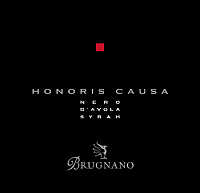
|
|
Honoris Causa 2008 |
|
| Brugnano (Sicily, Italy) | |
| Grapes: Nero d'Avola (75%), Syrah (25%) | |
| Price: € 16.00 | Score: |
| Honoris Causa shows an intense ruby red color and nuances of garnet red, little transparency. The nose denotes intense, clean, pleasing and refined aromas that start with hints of blackberry, black currant and violet followed by aromas of black cherry, blueberry, vanilla, tobacco, mace, chocolate and eucalyptus. The mouth has good correspondence to the nose, a properly tannic attack and however balanced by alcohol, good body, intense flavors, pleasing roundness. The finish is persistent with flavors of blackberry, plum and black currant. Honoris Causa ages for 12 months in barrique followed by at least 9 months of aging in bottle. | |
| Food Match: Broiled meat and barbecue, Roasted meat, Stewed and braised meat, Hard cheese | |
|
|
|
Alquimia 2011 |
|
| Brugnano (Sicily, Italy) | |
| Grapes: Muscat Blanc | |
| Price: € 18.00 - 50cl | Score: |
| Alquimia shows a pale amber yellow color and nuances of golden yellow, transparent. The nose denotes intense, clean, pleasing and refined aromas which start with hints of raisin, orange marmalade and dried fig followed by aromas of dried apricot, candied fruits, honey, peach jam, almond, lavender and lychee. The mouth has good correspondence to the nose, a sweet and round attack, however balanced by alcohol, good body, intense flavors, pleasing crispness. The finish is persistent with flavors of raisin, orange marmalade and dried apricot. Alquimia ages for 4 months in steel tanks. | |
| Food Match: Confectionery, Dried fruit tarts | |

|
|
Vino Nobile di Montepulciano Riserva 2006 |
|
| Godiolo (Tuscany, Italy) | |
| Grapes: Prugnolo Gentile (98%), Canaiolo Nero (1%), Colorino (1%) | |
| Price: € 21.50 | Score: |
| Vino Nobile di Montepulciano Riserva shows a brilliant ruby red color and nuances of garnet red, moderate transparency. The nose reveals intense, clean, pleasing, refined and elegant aromas which start with hints of black cherry, plum and violet followed by aromas of raspberry, blueberry, vanilla, tobacco, mace, chocolate, cinnamon and menthol. The mouth has good correspondence to the nose, a properly tannic attack and however balanced by alcohol, full body, intense flavors, pleasing roundness. The finish is persistent with flavors of black cherry, plum and raspberry. This Vino Nobile di Montepulciano Riserva ages for 18 months in cask. | |
| Food Match: Game, Roasted meat, Stewed and braised meat, Hard cheese | |

|
|
Vino Nobile di Montepulciano Riserva 2001 |
|
| Godiolo (Tuscany, Italy) | |
| Grapes: Prugnolo Gentile (98%), Canaiolo Nero (1%), Colorino (1%) | |
| Price: € 28.00 | Score: |
| Vino Nobile di Montepulciano Riserva shows a brilliant ruby red color and nuances of brick red, moderate transparency. The nose reveals intense, clean, pleasing, refined and elegant aromas which start with hints of plum, black cherry and dried violet followed by aromas of blueberry, raspberry, vanilla, tobacco, chocolate, cinnamon, leather, mace and menthol. The mouth has good correspondence to the nose, a properly tannic attack and however balanced by alcohol, full body, intense flavors, pleasing roundness. The finish is persistent with flavors of plum, black cherry and raspberry. Vino Nobile di Montepulciano Riserva ages for 24 months in cask. | |
| Food Match: Game, Roasted meat, Stewed and braised meat, Hard cheese | |
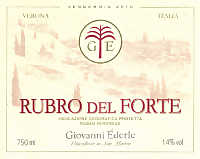
|
|
Rubro del Forte 2010 |
|
| Giovanni Ederle (Veneto, Italy) | |
| Grapes: Corvina, Corvinone, Rondinella, Croatina | |
| Price: € 17.50 | Score: |
| Rubro del Forte shows a brilliant ruby red color and nuances of garnet red, moderate transparency. The nose denotes intense, clean, pleasing and refined aromas which start with hints of black cherry, plum and blackberry followed by aromas of dried violet, tobacco, vanilla, chocolate, cinnamon and mace. The mouth has good correspondence to the nose, a properly tannic attack and however balanced by alcohol, good body, intense flavors, pleasing roundness. The finish is persistent with flavors of black cherry, plum and blackberry. Rubro del Forte ages for 12 months in cask followed by 12 months of aging in bottle. | |
| Food Match: Roasted meat, Stewed meat, Braised meat, Hard cheese | |
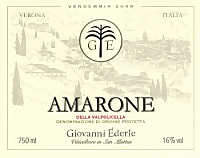
|
|
Amarone della Valpolicella 2009 |
|
| Giovanni Ederle (Veneto, Italy) | |
| Grapes: Corvina, Rondinella | |
| Price: € 38.00 | Score: |
| This Amarone della Valpolicella shows an intense ruby red color and nuances of garnet red, little transparency. The nose denotes intense, clean, pleasing and refined aromas which start with hints of blackberry, plum and dried violet followed by aromas of black cherry, vanilla, tobacco, chocolate, mace, leather and menthol. The mouth has good correspondence to the nose, a tannic attack and however balanced by alcohol, full body, intense flavors, pleasing roundness. The finish is persistent with flavors of blackberry, plum and black cherry. This Amarone della Valpolicella ages for 15 months in cask followed by 6 months of aging in bottle. | |
| Food Match: Game, Roasted meat, Stewed and braised meat, Hard cheese | |
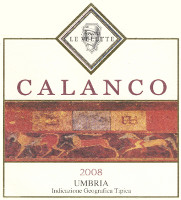
|
|
Calanco 2008 |
|
| Le Velette (Umbria, Italy) | |
| Grapes: Sangiovese (65%), Cabernet Sauvignon (35%) | |
| Price: € 16.00 | Score: |
| Calanco shows an intense ruby red color and nuances of garnet red, little transparency. The nose denotes intense, clean, pleasing and refined aromas which start with hints of black cherry, black currant and plum followed by aromas of violet, blackberry, blueberry, vanilla, cocoa, tobacco and eucalyptus. The mouth has good correspondence to the nose, a properly tannic attack and however balanced by alcohol, good body, intense flavors, pleasing roundness. The finish is persistent with flavors of black cherry, black currant and blueberry. Calanco ages for 16 months in barrique followed by 14 months of aging in bottle. | |
| Food Match: Roasted meat, Stewed meat, Braised meat, Hard cheese | |
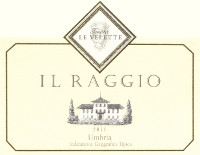
|
|
Il Raggio 2010 |
|
| Le Velette (Umbria, Italy) | |
| Grapes: Muscat Blanc, Sauvignon Blanc, Chardonnay, Grechetto | |
| Price: € 15.50 - 50cl | Score: |
| Il Raggio shows a pale amber yellow color and nuances of amber yellow, transparent. The nose denotes intense, clean, pleasing and refined aromas that start with hints of dried fig, almond and raisin followed by aromas of citrus fruit peel, date, honey, vanilla, plum and nail polish. The mouth has good correspondence to the nose, a sweet and round attack, however balanced by alcohol, good body, intense flavors, pleasing crispness. The finish is persistent with flavors of dried fig, almond and honey. Il Raggio ages in cask for 6 months followed by at least 6 month of aging in bottle. | |
| Food Match: Confectionery, Dried fruit tarts | |
News |
|
In this section are published news and information about events concerning the world of wine and food. Whoever is interested in publishing this kind of information can send us a mail to our address.
|
AquavitaeReview of Grappa, Distillates and Brandy |
|
|
| Distillates are rated according to DiWineTaste's evaluation method. Please see score legend in the "Wines of the Month" section. |

|
|
Brandy di Morellino di Scansano Oro di Nero 2004 |
|
| Villa Acquaviva (Tuscany, Italy) | |
| (Distiller: Distilleria Nannoni) | |
| Raw matter: Morellino di Scansano | |
| Price: € 70.00 - 50cl | Score: |
| This brandy shows a deep golden yellow color, limpid. The nose reveals intense, clean, pleasing and refined aromas of prune, dried violet, hazelnut, chocolate, honey, tobacco and praline, with almost imperceptible alcohol pungency. In the mouth has intense flavors with perceptible alcohol pungency which tends to dissolve rapidly, good correspondence to the nose, pleasing roundness, balanced sweetness. The finish is persistent with flavors of prune, hazelnut and chocolate. Alcohol 45%. | |
Wine Parade |
|
|
| The best 15 wines according to DiWineTaste's readers. To express your best three wines send us an E-mail or fill in the form available at our WEB site. |
| Rank | Wine, Producer | |
|---|---|---|
| 1 |
| San Leonardo 2006, Tenuta San Leonardo (Italy) |
| 2 |
| Avvoltore 2009, Moris Farms (Italy) |
| 3 |
| Trento Brut Riserva Methius 2006, Dorigati (Italy) |
| 4 |
| Trento Talento Brut Riserva 2007, Letrari (Italy) |
| 5 |
| Confini 2007, Lis Neris (Italy) |
| 6 |
| Camartina 2008, Querciabella (Italy) |
| 7 |
| Franciacorta Pas Dosé Récemment Dégorgé 2006, Cavalleri (Italia) |
| 8 |
| Brunello di Montalcino 2007, Donatella Cinelli Colombini (Italy) |
| 9 |
| Verdicchio dei Castelli di Jesi Classico Superiore Podium 2010, Garofoli (Italy) |
| 10 |
| Sagrantino di Montefalco Collepiano 2007, Arnaldo Caprai (Italy) |
| 11 |
| Amarone della Valpolicella Classico Capitel Monte Olmi 2007, Tedeschi (Italy) |
| 12 |
| Offida Rosso Il Grifone 2006, Tenuta Cocci Grifoni (Italy) |
| 13 |
| Villa Gresti 2006, Tenuta San Leonardo (Trentino, Italy) |
| 14 |
| Brunello di Montalcino Vigna Loreto 2007, Mastrojanni (Toscana, Italy) |
| 15 |
| Adarmando 2009, Tabarrini (Italy) |
| |||||||
Privacy Policy | |||||||


| Copyright © 2002-2024 Antonello Biancalana, DiWineTaste - All rights reserved |
| All rights reserved under international copyright conventions. No part of this publication and of this WEB site may be
reproduced or utilized in any form or by any means, electronic or mechanical, without permission in writing from DiWineTaste. |